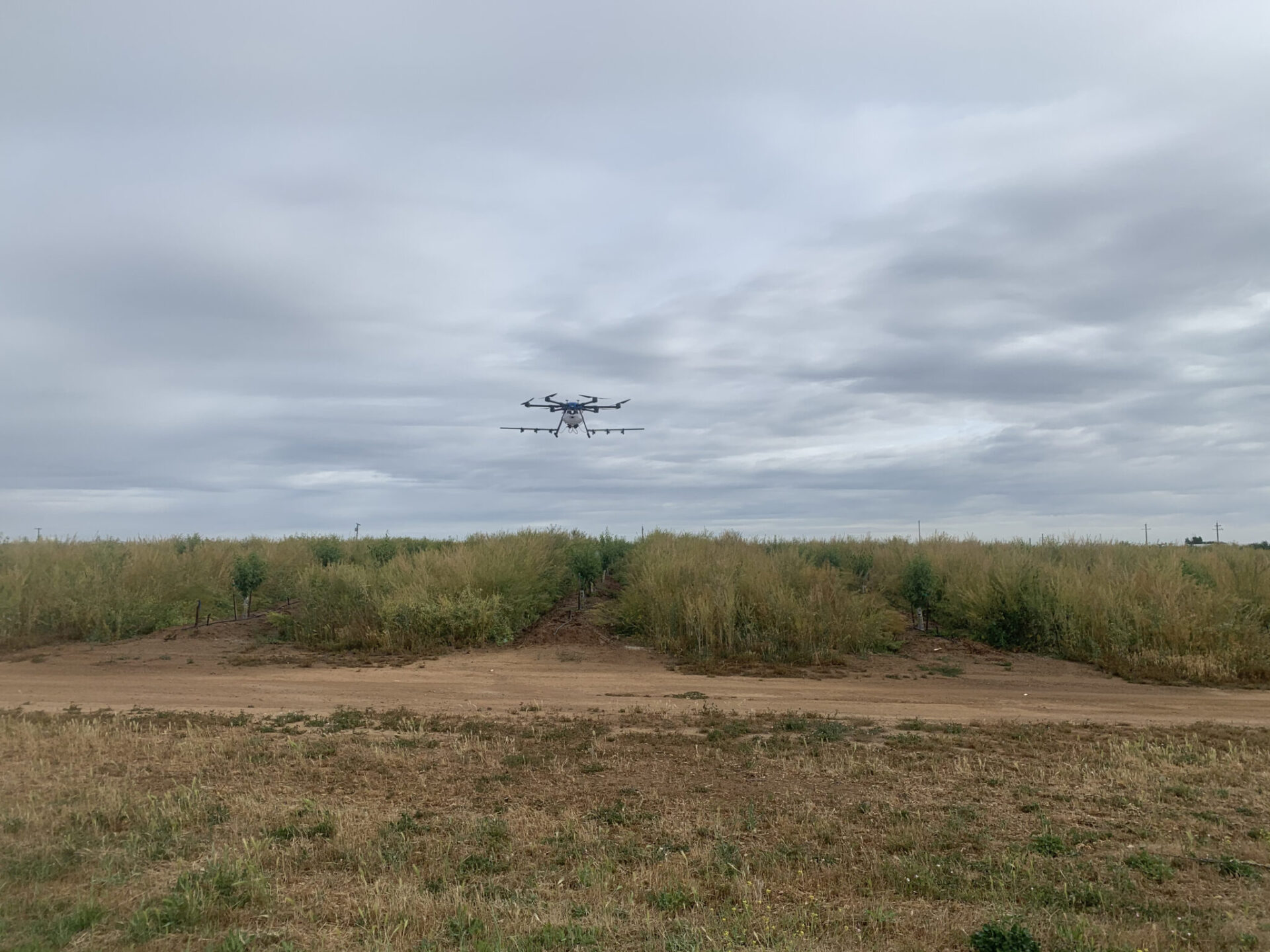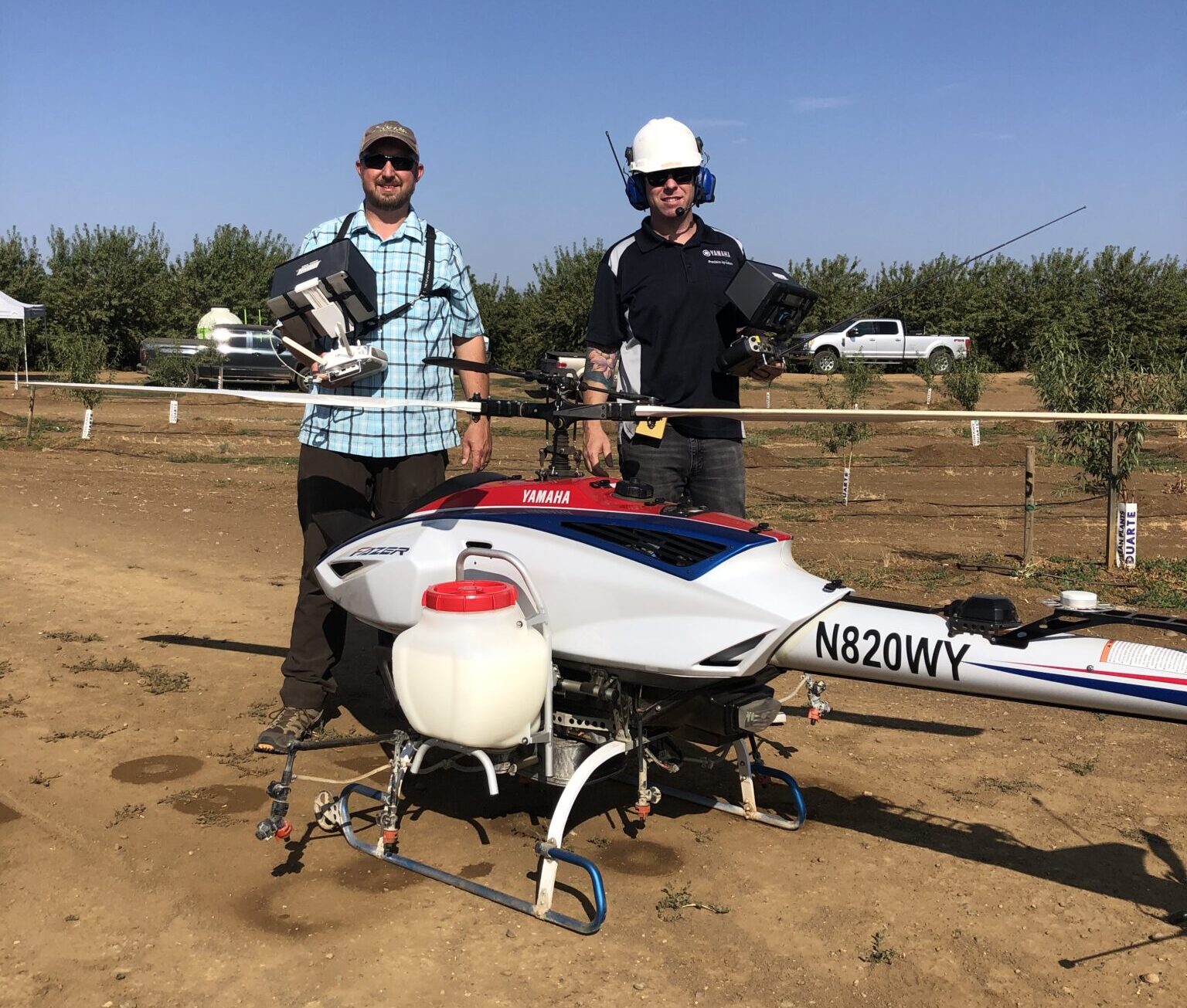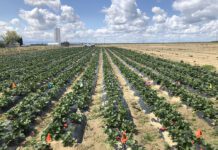
Research in a Colusa County almond orchard that compared insecticide applications using an unmanned aerial vehicle to an airblast sprayer found no statistical differences in navel orangeworm (NOW) control.
But Ken Giles, a UC Davis professor emeritus in biological and agricultural engineering and one of the researchers, warned against drawing conclusions or extrapolating the results to other situations. The trial involved only one orchard, one crop protection material, two almond varieties, one UAV model and one season of data.
“We really want to be cautious, especially early on with these trials,” he said. “In this experiment, it worked well and we’re encouraged with the future.”
Instead, he said the results of the 2018-19 study should be used to guide future multidisciplinary research into applications using UAVs, also referred to as drones.
Based on his experiences with UAVs that date back more than a decade, Giles said he doesn’t view them as replacements for ground sprays or aerial applications but rather complementary.
“They have some unique features like the ability to treat individual rows,” he said. “Particularly at hull split where you have the pollinizer and Nonpareil, we can make split applications. We can make an application to the top of the trees where hull split occurs first. I’m encouraged that this can be a different tool for managing [navel orangeworm].”
Joining Giles in the trial were Franz Niederholzer, UCCE farm advisor for Colusa, Sutter and Yuba counties, and John Andaloro, Edward Lang and Lawrence Watson from FMC Corp.’s Stine Research Center in Newark, Del.
Their research, titled “Evaluation of an unmanned aerial vehicle as a new method of pesticide application for almond crop protection,” was published in the Aug. 20, 2020 peer-reviewed journal Pest Management Science.

UAV Put to the Test
The trial involved a DJI Matrice 600 UAV retrofitted with a commercial spray system and control software customized by Leading Edge Aerial Technologies Inc. of Asheville, North Carolina.
During 2018, the researchers conducted what amounted to a proof of concept trial in an Arbuckle almond orchard using the UAV to apply a single insecticide rate at two different volumes. The orchard was planted to Nonpareil, with Fritz as the pollinizer.
In 2019, the trial consisted of three blocks of almond trees—two that were a half-acre each for UAV applications and one 2-acre block for the ground rig, which served as the control. FMC’s Altacor (chlorantraniliprole) was used at hull split to control navel orangeworm.
The UAV treatments involved spray volumes of 5 gallons per acre and 10 gallons per acre. The airblast sprayer used a volume of 100 gallons per acre, which was based on the product label for mature almond and tree nuts.
The first applications were made at about 5% hull split when most eggs were laid by second-generation NOW moths. The second application 14 days later was made when hull split had expanded into the inner and lower canopy. Nuts in the upper canopy were completely open at this time and susceptible to third-generation NOW infestations.
The researchers placed water-sensitive cards and filter paper at 8, 12 and 16 feet above the ground to represent lower, middle and upper canopies to estimate spray coverage.
They showed the UAV produced large deposits and sparse coverage at the two different spray volumes. The airblast sprayer, on the other hand, produced smaller deposits with denser coverage. Overall, the airblast sprayer provided better spray coverage than the drone application.
The researchers also measured insecticide residues by randomly hand collecting three to five nuts each from the lower, middle and upper canopy levels and washing the chemical from the surface of unhulled nuts.
Measured pesticide levels varied widely, which is typical of agricultural applications, the researchers reported.
Altogether, pesticide residues were similar between the drone and ground applications, but the interactions between canopy elevation and spray methods were statistically significant.
The drone applications had more insecticide residue in the upper and middle canopies, whereas the ground application had more residue in the lower portion of the canopy. This reflected the top-down spray for aerial application versus the bottom-up spray with a ground rig.
NOW crop damage assessed in field samples during the 2019 trial ranged from 3% to 5% among the treatments, which was not statistically significant. Giles pointed out that NOW damage in field samples may run as high as twice that reported on grade sheets because the crop hasn’t yet gone through sorters, airlegs and other machinery to remove damaged kernels.
The researchers also noted that changes in application timing as well as different almond varieties may influence the results, especially if the highly susceptible Nonpareil variety is involved.

Follow-Up UAV Use
In addition to the NOW experiment, Giles has used a UAV to apply pheromones during a NOW mating disruption trial. Although the chemical didn’t reduce damage compared to the grower standard program, the application proved successful.
Niederholzer also has enlisted a UAV since the NOW trial. Not wanting to drive in a young almond orchard at the Nickels Soil Lab near Arbuckle where he serves as research coordinator, he hired a UAV to apply a fungicide and miticide ahead of rain in May 2020.
Niederholzer said the applications appeared to work (no leaf drop), although he has no data to back his observations because they were not part of replicated experiments.
“We did it, among other things, to see if it could be done and provide some flexibility on applications,” he said.
The applications were made by a multi-rotor unit that had a three-gallon payload.
“Even at a rate of a few gallons per acre, reloading takes a while, and it had to come back and we had to change the battery,” he said. “They certainly have their limitations at this stage of development. On the positive side, there’s a potential for using that kind of equipment for systemic, baited or pheromone materials, where coverage isn’t critical or on very young trees where targeted spraying reduces pesticide costs. But the drones just don’t have that much volume, particularly where complete coverage is critical in medium to large trees.”

From Small to Large
The ultimate utility of UAVs for orchard applications may depend on their payloads, intended use and crop protection material labels.
Multi-rotor craft, such as DJI’s, can carry payloads on average of 2 to 5 gallons. They tend to have short flying times of less than 20 minutes before they have to return for battery recharging or swap-out. These are the same off-the-shelf craft that have become popular with hobbyists. The FAA classifies those less than 55 pounds as small unmanned aerial systems, falling under its Part 107 rules.
Yamaha Motor Corp. manufactures a series of UAVs that more closely resemble small helicopters. The gasoline-powered R-MAX model was the first UAV over 55 pounds to gain an FAA unmanned aircraft system exemption to conduct agricultural operations in the United States. The heavier craft fall under a different set of FAA rules.
For the past four years, Yamaha has offered custom application services to Napa Valley winegrape growers, said Bill Coy, agricultural business development manager. The division started with the R-MAX and has since added the FAZER model, which has a 50% larger payload than the previous model.
“Where our service seems to be the most successful in winegrapes is in hard-to-reach areas that are currently done by crews with backpack sprayers or in areas that might be real treacherous to get tractors into because of the terrain,” he said.
A crew of two, which includes a licensed pilot and an observer/chemical mixer/loader, conducts the spray applications.
In late July, one of Yamaha’s UAVs applied a miticide to a young almond orchard near Maxwell as a trial to gauge its applicability to tree crops, Coy said.
“We know what our capabilities are in winegrapes, but we’d like to learn more about what the challenges are for almond growers to see if we could be a fit to address some of those,” he said. “That’s why I’m excited to learn about the effectiveness of the application.”
As part of the trial, Coy said he hoped to receive input from area almond growers and pest control advisors.
Still, other companies have larger craft in the works. The Pyka Pelican, an autonomous electric aircraft, is about the size of a Piper Cub. It requires a 300-foot runway for takeoff and landing and can carry up to a 650-pound payload. The Oakland-based developers already have used a smaller model in other countries to spray crops. They also are accumulating flight time in rural Northern California to show the air worthiness of the craft before they seek FAA licensing.

What the Future Holds
The 2018-19 almond orchard experiment involved Altacor (chlorantraniliprole), which has a label calling for minimum volumes of 30 gallons per acre for both ground and aerial application for nuts. Although the volumes are not unusual for many products where coverage is key, they could be limiting, particularly for drones with smaller payloads.
“The label is controlled by the registrant,” Giles said. “What we’re seeing now is almost every registrant has an R&D program looking at UAV application. They know this technology is coming along, and they want to understand how their products fit.”
At the same time, a number of product labels have aerial application volumes as low as five gallons per acre, he said. If the label allows aerial application and does not prohibit application by UAV, then the product can be applied by a drone providing several criteria are met, Giles said.
UAV applicators must be part of businesses with an FAA Section 137 certificate, which is the same requirement as crop dusters. They also must have a California Department of Pesticide Regulation pest control aircraft manned or unmanned pilot certificate and an FAA Part 107 pilot’s license, said Giles, who holds both certificates as well as a commercial pilot’s license.















